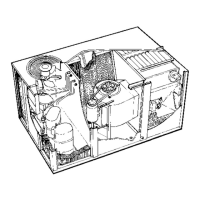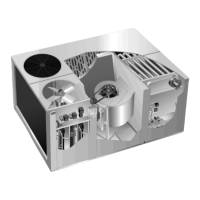Page 29
B-Cooling StartUp
NOTE - The following is a generalized procedure and
does not apply to all thermostat control systems. Elec
tronic and ramping thermostat control systems may
operate differently. Refer to the operation sequence
section of this manual for more information.
1- Set fan switch to AUTO or ON and move the system
selection switch to COOL. Adjust the thermostat to a
setting far enough below room temperature to bring
on the compressor.
2- Close unit disconnect switch. Compressor will start
and cycle with demand.
3- The refrigerant circuit is charged with HCFC22 refrig
erant. See unit rating plate for correct amount of
charge.
4- Refer to the Refrigeration System Service Checks
section for the proper method to check refrigerant
charge.
C-Heating StartUp:
CAUTION - This unit is equipped with a direct
spark ignition system. Do not attempt to light
manually.
1- Set thermostat to OFF position. Close manual knob
on gas valve.
2- Wait 5 minutes.
3- Open manual knob on gas valve, replace burner ac
cess door and turn on unit electrical supply.
4- Set the fan switch to AUTO or ON and move the sys
tem selection switch to HEAT. Adjust the thermostat
setting above room temperature.
5- The combustion air blower immediately starts. The
burner lights within 40 sec.
6- If the unit does not light the first time, it will attempt up
to two more times before locking out.
7- If lockout occurs,repeat steps 1, 2, 3 and 4.
D-Safety or Emergency Shutdown:
Turn off power to the unit. Close the manual and/or main
gas valves.
E-Extended Period Shutdown:
Turn off the thermostat or set to UNOCCUPIED" mode.
Close all gas valves both internal and external to the unit to
prevent gas leakage into the combustion chamber. Turn
off power to the unit. All access panels, covers and vent
caps must be in place and secured.
VI-REFRIGERATION SYSTEM
SERVICE CHECKS
The charge should be checked during startup using the
method outlined below.
A-Gauge Manifold Attachment
Service gauge ports are identified in figures 22 and 23. At
tach gauge manifold high pressure line to liquid line gauge
port on thermometer well. Attach gauge manifold low
pressure line to suction line service port.
NOTE - When unit is properly charged (whether by ap
proach or subcooling method) liquid line pressures
should approximate those given in table 13.
B-Charging
It is not recommended that the system be charged below
60F (15C). If charging below 60F is required or if the
system is completely void of refrigerant, the recom
mended and most accurate method of charging is to weigh
the refrigerant into the unit according to the amount shown
on the unit nameplate and in the specifications table. If
weighing facilities are not available or if the unit is just low
on charge, use the following procedures:
Unit Void of Refrigerant
1- Connect an upright HCFC22 drum to the center port
of gauge manifold. Purge air from connecting line.
2- Start unit.
3- Open drum valve and charge a quantity of refrigerant
gas into the system through the compressor suction
port, then close refrigerant drum valve. Allow unit to
run for a few minutes to stabilize operating pressure.
Determine correct charge as follows.
CHECKING CHARGE
ALL UNITS
1- This method uses a thermometer inserted in the ther
mometer well to check liquid line temperature. Make
sure thermometer well is filled with oil before check
ing.
2- Allow unit to run for at least five minutes to stabilize
pressures.
GCS16H-261/311, GCS16-411/413
and GCS16R-411 ONLY
(GCS16-510/650 skip to step 6)
(Subcooling Method)
3- If ambient temperature is above 60F (15C), place
thermometer in well and read temperature.

